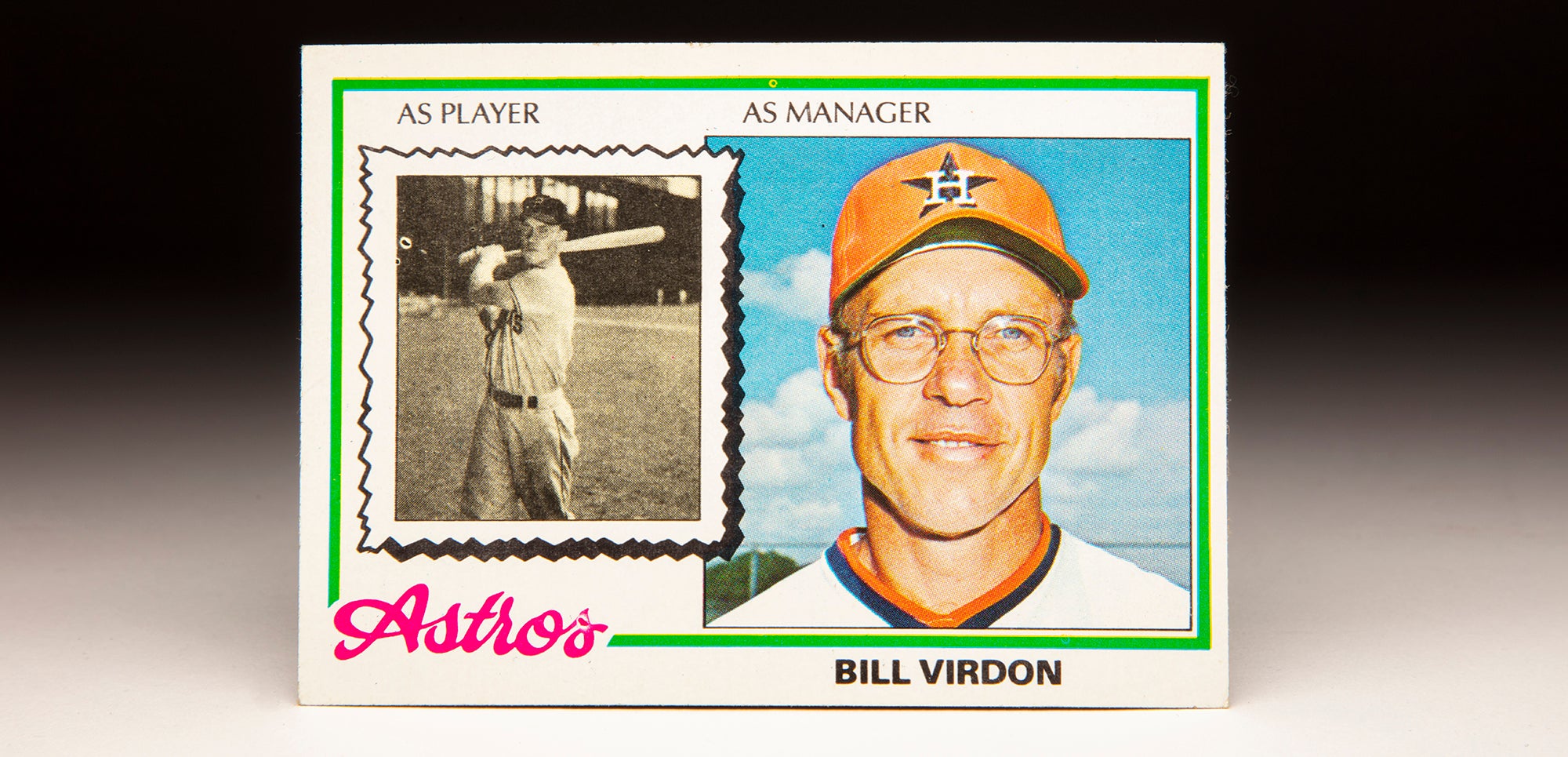- Home
- Our Stories
- #CardCorner: 1953 Topps Dick Groat
#CardCorner: 1953 Topps Dick Groat
The combination of power and speed has long been valued in baseball. But Dick Groat managed the complete opposite.
In 1956, the Pirates shortstop became the only player in history to record at least 500 at-bats in a season where he failed to hit a home run or steal a single base. It could be an unbreakable record.
And yet, Groat completed his 14-year big league career with eight All-Star Game selections, a National League Most Valuable Player Award (and another season where he was runner-up) and two World Series rings.
Few shortstops were more respected in their time.

Richard Morrow Groat was born Nov. 4, 1930, in Wilkinsburg, Pa. – eight miles due east of downtown Pittsburgh. He starred in both baseball and basketball for Swissvale High School and even took up volleyball, showcasing the all-around skills that would make him a multi-sport legend.
“I learned volleyball from scratch,” Groat told the Pittsburgh Post-Gazette in 1996. “It was a fun game between basketball and baseball.”
Groat graduated in 1948 and earned a basketball scholarship at Duke University when his brother, Marty, asked local football legend John Michelosen, who would coach the NFL’s Pittsburgh Steelers from 1948-51, to put in a good word for him with his friends at the Durham, N.C., school.
Freshmen were ineligible to play varsity ball in that era, but Groat showed his talent as a sophomore, averaging 14.5 points per game in the 1949-50 season. He improved his average to 25.2 points per game as a junior and then finished second in the nation in scoring as a senior with a mark of 26.0 points per contest, just behind Kansas star Clyde Lovellette and his 28.4 points per game. Groat also averaged 7.6 assists and 7.6 rebounds per game as a senior and scored 48 points in his final regular season game against North Carolina, setting a school record that would stand until Danny Ferry scored 58 points against Miami during the 1988-89 season. Groat’s mark still ranks second in school history, and No. 10 jersey was retired by the school following his senior year.
Lovellette, meanwhile, became the 10th overall pick in the first round in the 1952 NBA Draft – seven picks after the Fort Wayne Pistons, which later moved to Detroit – took Groat.
Groat made his NBA debut in the Pistons’ first game of the 1952-53 season, and one week later scored 25 points against the New York Knicks. But these were not Groat’s first forays into pro sports. He signed with the Pirates after his senior season at Duke, bypassing the minor leagues completely after leading the Blue Devils to the College World Series that spring.
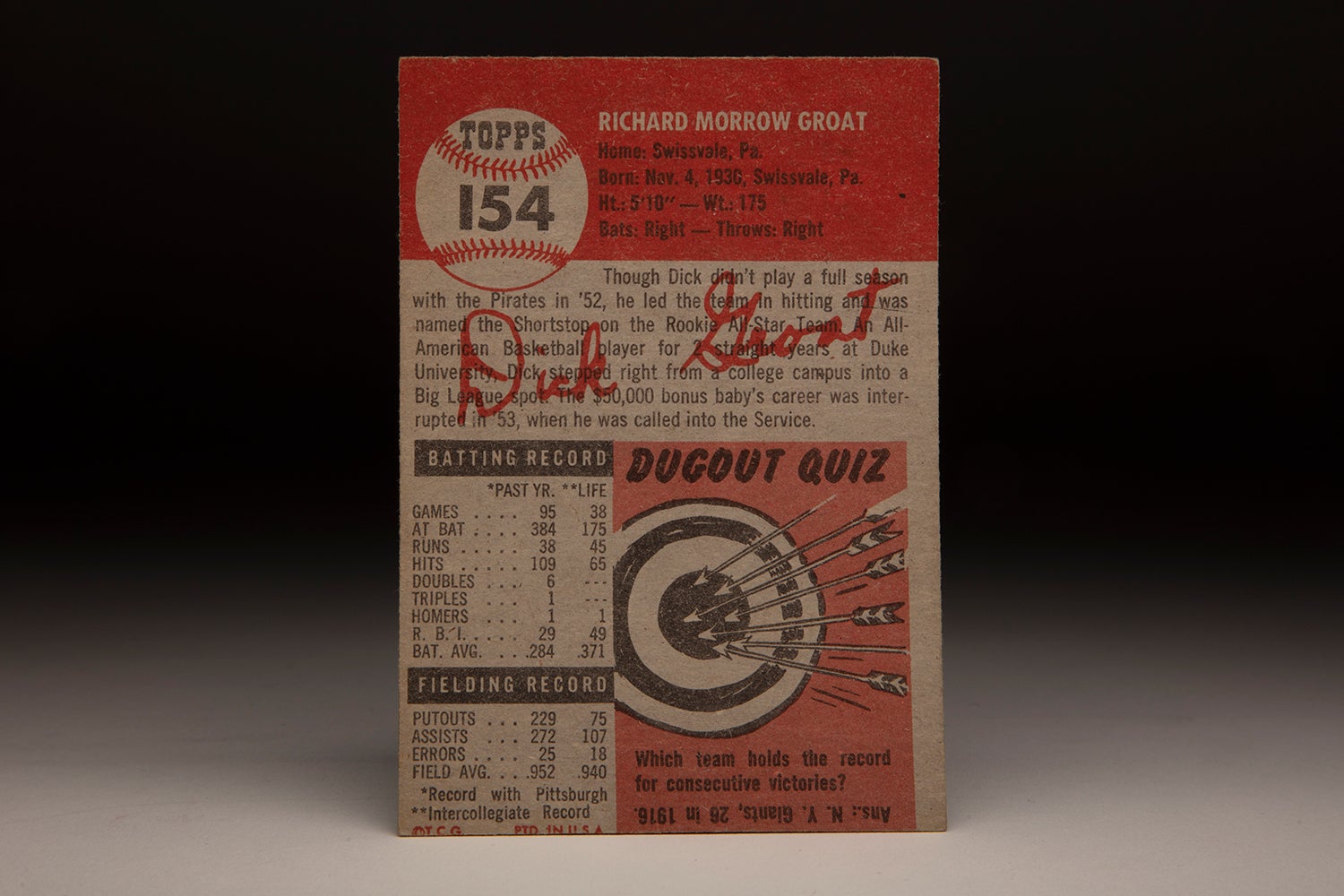
Groat’s bonus with the Pirates was reported at figures ranging from $25,000 to $75,000, and he debuted with Pittsburgh on June 18 against the Giants as a pinch-hitter. The next day, Groat was in the lineup as the starting shortstop at the Polo Grounds. He finished the season hitting .284 with 109 hits in 95 games, earning a third-place finish in the National League Rookie of the Year vote.
But Groat’s two-sport career was interrupted in the winter of 1953 when he was inducted into the United States Army. He served two years with the Corps of Engineers in Fort Belvoir, Va., before being discharged in February of 1955.
Though basketball remained his favorite game, Groat sensed his future was on the diamond.
“It all depends on the coming baseball season,” Groat told the Associated Press when he was discharged from the Army. “If I have a good year, I may give up basketball.”
Groat did have a good year in 1955, earning the Opening Day nod at shortstop and hitting .267 with 28 doubles and 51 RBI. Groat decided he wanted to play in the NBA that fall and had a contract with the Pistons – but Pirates general manager Branch Rickey vetoed Groat’s plans.
“Mister Rickey did not allow me to do both,” Groat told the Post-Gazette.
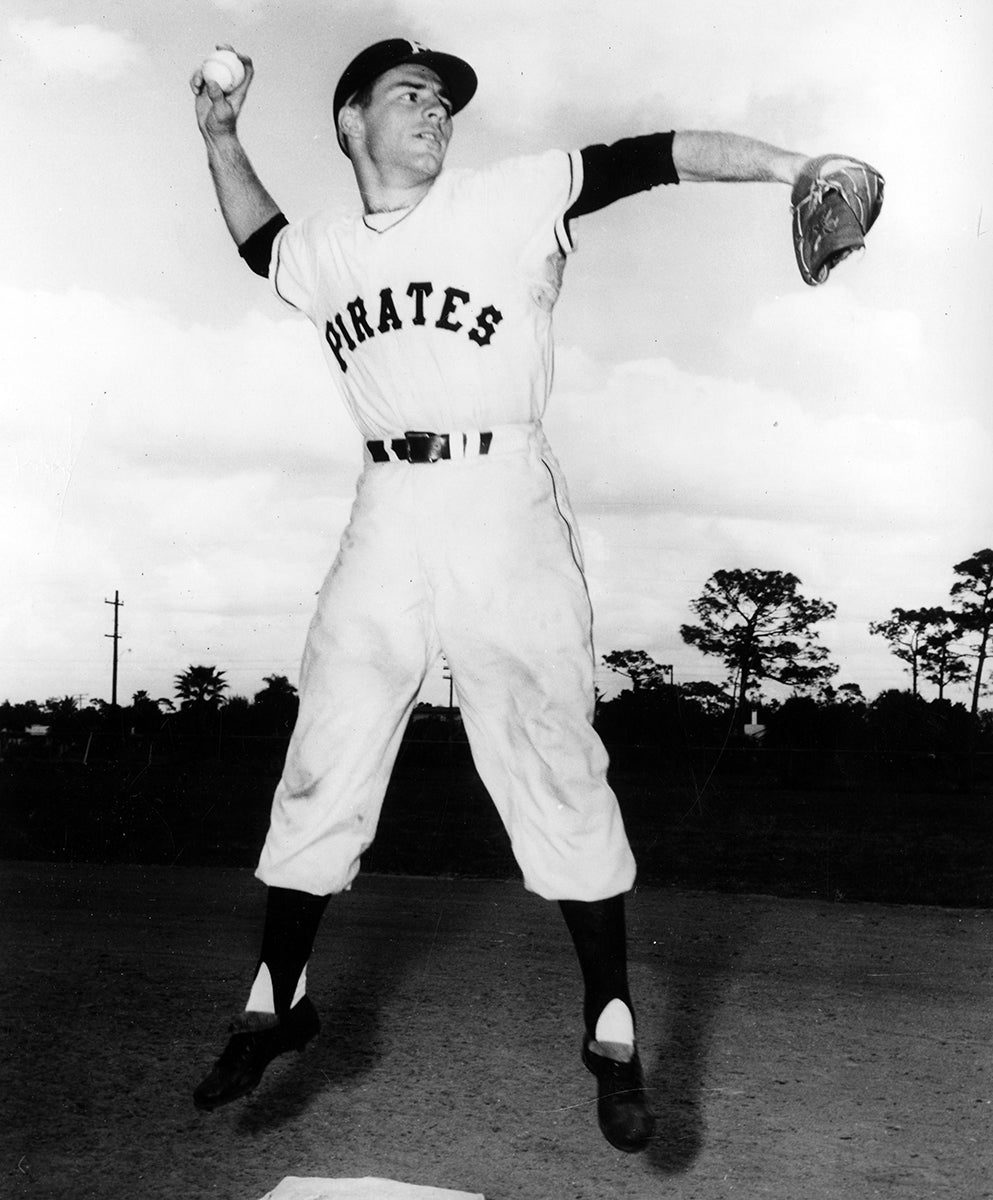
Rickey was replaced by Joe Brown as Pirates general manager prior to the 1956 season, and Brown began building on the foundation Rickey laid to resurrect the Pirates from four straight last place finishes from 1952-55. Groat compiled his unique zero homer/zero steal stat line in 1956 but still hit .273 in 142 games. Then in 1957, Groat was hitting .352 on May 26 when he injured his right ankle on the first base bag while beating out an infield hit. The injury cost him three weeks on the sidelines and limited him to 125 games that year – a season where he finished with a .315 batting average.
In 1958, the Pirates finished above .500 for the first time in 10 seasons, going 84-70 while Groat hit .300 while leading the team in hits (175) and doubles (36). He teamed with Bill Mazeroski to give Pittsburgh one of the top double play combos in the game (Groat led all NL shortstops with 127 double plays) and formed the heart of a roster – along with Roberto Clemente, Roy Face, Bob Friend and Vern Law – that would be the backbone of the franchise for years to come.
“For the first time since I joined this club in 1952, we have an honest-to-goodness, legitimate chance to win the pennant,” Groat told United Press International in the spring of 1959. “Take Bill Mazeroski at second base. You can’t appreciate how great he is until you work in the same infield with him. On double plays, it looks like the ball gets to him and leaves him on a 180-degree angle. You hardly even see him touching it.”
The Pirates did not reach their goal in 1959, sliding to 78-76 as Groat hit .275. But he earned his first two All-Star Game selections and continued his role as Pirates captain, helping manager Danny Murtaugh steer the ship.
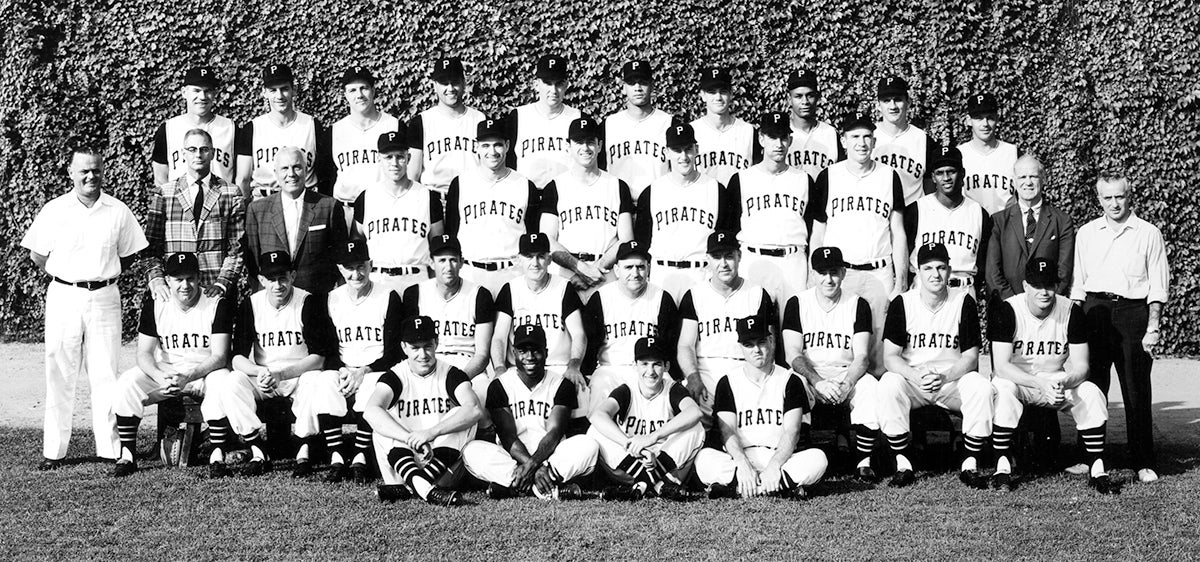
Then in 1960, Groat and the Pirates had a magical season. The Bucs got off to a hot start – winning 22 of their first 32 games – and Groat, hitting out of his customary No. 2 hole, peppered the league with line drives. But on Sept. 6 – with Pittsburgh closing in on its first pennant in 33 years – Groat was hit by a pitch by Milwaukee’s Lew Burdette and suffered a fractured left wrist. The injury was expected to sideline Groat for the rest of the regular season, leaving a small chance that he might be ready for the World Series if the Pirates took the flag.
Suddenly, backup shortstop Dick Schofield was thrust into a prominent role.
“Groat is a great player, a team leader, a guy who can do everything,” Cardinals manager Solly Hemus told the AP. “But Schofield is a capable ballplayer.”
Hemus knew Schofield from his time with the Cardinals, and Schofield did not disappoint – batting .350 with a .443 on-base percentage in 19 games before Groat returned to the starting lineup on Oct. 1.
Groat finished the season batting .325 – the top mark in the National League – and the Pirates won the pennant by seven games over the Braves and nine over the Cardinals.
The World Series, however, would see the Pirates match up with the Yankees – a team that had won 10 of the last 12 AL pennants and seven Fall Classic titles in that span. New York was a prohibitive favorite, even with Groat back in the lineup.
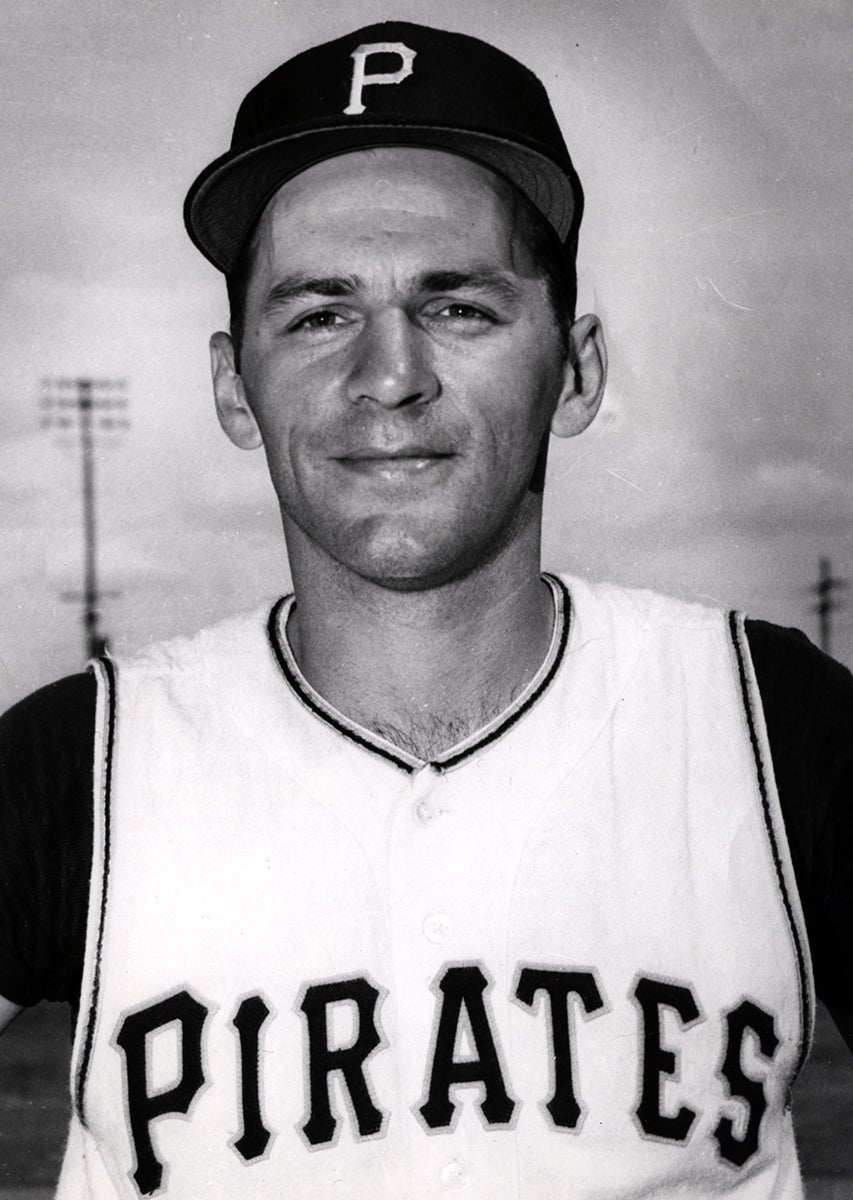
The World Series featured three Yankees blowouts and three close wins by Pittsburgh heading into Game 7 at Forbes Field. Groat went 2-for-4 in Game 1, tying the contest with an RBI double in the bottom of the first and then scoring the go-ahead run on a single by Bob Skinner, giving the Pirates a lead they would never relinquish in a 6-4 victory.
Groat added hits in Games 2, 5 and 6. But after taking a 4-0 lead through two innings in Game 7, the Pirates found themselves down 7-4 entering the bottom of the eighth. But after Gino Cimoli led off the inning with a single, Bill Virdon followed with a grounder to short that looked like a double play ball. But the ball struck a rock in the infield and caromed into the neck of Yankees shortstop Tony Kubek, leaving both Cimoli and Virdon safe.
Groat followed with a single to left that scored Cimoli, cutting New York’s advantage to 7-5. After Skinner bunted the runners over and Rocky Nelson flied out, Clemente hit an infield single that scored Virdon and pushed Groat to third. Hal Smith then followed with one of the most impactful home runs in big league history, a three-run shot that scored Groat and Clemente to give Pittsburgh a 9-7 lead.
New York extended the drama by scoring two runs in the top of the ninth before Mazeroski ended the World Series on a walk-off home run to give Pittsburgh the title.
Following the season, Groat was named the National League Most Valuable Player, easily outdistancing runner-up Don Hoak, Groat’s Pittsburgh teammate, by a margin of 276-162.
“Just to play on the club was great – just great,” Groat told the AP after learning he was named MVP. “It was a wonderful team effort and I was just a part of it.”
Groat and the Pirates could not repeat their titles in 1961 as Pittsburgh finished sixth in the NL with a mark of 75-79 and Groat hit .275. But they both bounced back in 1962 as the Pirates won 93 games to finish fourth while Groat hit .294 with 199 hits. He started both All-Star Games at shortstop that year and finished 16th in the NL MVP race, tallying a career-best and NL high 521 assists at shortstop.

But with Groat having turned 32 two weeks before, the Pirates traded their shortstop to the Cardinals on Nov. 19, 1962, along with pitcher Diomedes Olivo for pitcher Don Cardwell and young infielder Julio Gotay.
“He’s one of the best in the league at handling the bat,” Cardinals manager Johnny Keane told the AP about Groat following the trade. “He’s as good as anyone in baseball in the No. 2 spot in the batting order. He’s a real leader in every way.”
Groat was understandably shaken by the trade but quickly embraced a Cardinals club that was building the foundation for a mini dynasty. In 1963, Groat compiled what would arguably be his best season, hitting .319 with 201 hits, an MLB-best 43 doubles, 11 triples and a career-high 73 RBI. The Cardinals and Dodgers battled for the NL pennant down the stretch before Los Angeles prevailed – and following the season LA’s Sandy Koufax edged Groat in the NL MVP voting, with Groat finishing in the runner-up spot just 47 points back of first place.
In 1964, however, the Cardinals won their first NL pennant in 18 seasons as Groat once again was the glue in the Redbirds’ lineup. Batting .292 with 35 doubles and 70 RBI, Groat earned his fourth straight starting assignment in the All-Star Game and once again led NL shortstops with 499 assists.
Groat hit just .192 in the World Series but was involved in several pivotal moments. In Game 4, the Yankees were leading 3-0 in the fourth inning when Groat and pitcher Roger Craig executed a pickoff play at second base to erase Mickey Mantle and end the inning with two on and two out. Then in the sixth inning with the score still 3-0, Groat hit a grounder to second with two on and one out – a ball that looked like a double play all the way. But Yankees second baseman Bobby Richardson was charged with an error on the throw to second base, allowing all runners to be safe. Ken Boyer followed with a grand slam to give the Cardinals a 4-3 lead that they would protect the rest of the way, tying the World Series at two games apiece.
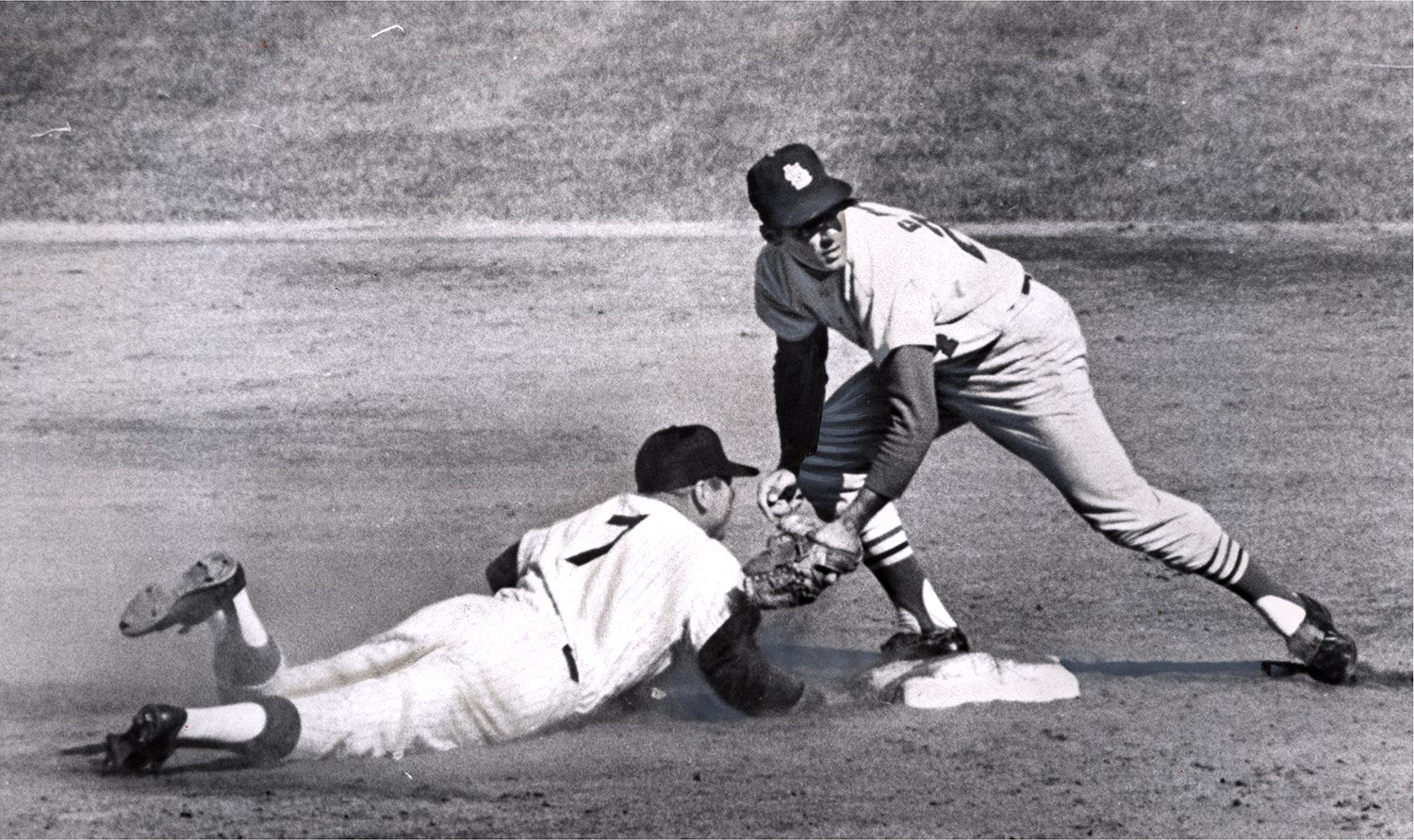
The series went to a deciding Game 7, where Groat was again at the center of the action. In the fourth inning of a scoreless game, Boyer singled to lead off the frame and Groat followed with a walk. Tim McCarver then grounded to first baseman Joe Pepitone, who threw to second base to force Groat. But Groat broke up the potential double play and forced shortstop Phil Linz to throw wildly to first, allowing Boyer to score the game’s first run. The Cardinals scored two more runs that inning to take a 3-0 lead.
“Dick Groat hit me on the play,” an emotional Linz told United Press International after the game. “But that was after I got rid of the ball. I just threw wide.”
Groat’s fifth-inning groundout gave St. Louis a 5-0 lead that became a 6-0 advantage in the same inning. Bob Gibson, starting his third game of the series, began to tire in the middle innings but the Cardinals still held a 7-3 advantage going to the ninth.
Keane then stuck with Gibson as the Yankees scored twice, with the Cardinals ace finishing his 27th inning of the series to wrap up a 7-5 win.
A UPI photo of a balding Groat, looking like a coach or manager, celebrating with Gibson ran in newspapers across the country after Game 7.
“Winning that first World Series was a big thrill,” Groat told the Pittsburgh Press after Game 7. “But for me personally, there is nothing to match this effort by the Cardinals.”
Groat began showing signs of age in 1965 when he hit .254, his lowest mark in any big league season. On Oct. 27, the Cardinals packaged Groat along with veterans Bob Uecker and Bill White in a deal that brough Pat Corrales, Alex Johnson and Art Mahaffey back from the Phillies.
The Phillies envisioned Groat as a versatile veteran who could help at several positions, but Groat played in 139 of his 155 games in 1966 at shortstop, batting .260 with 53 RBI. But it would be his last season as an MLB regular.
Groat ceded the Phillies starting shortstop job to Bobby Wine in 1967 and had his contract purchased by the Giants on June 22 after appearing in only 10 games with Philadelphia. He played in 34 games with San Francisco, ending the year with a .156 batting average in 44 contests.

On Sept. 16, 1967, Groat announced he would retire as an active player at the end of the season. He was rumored to be a candidate for the Pirates’ managerial job but instead concentrated on business interests, including owning and operating Champion Lakes Golf Course in Ligonier, Pa., just 51 miles from Pittsburgh.
A member of both the National High School Sports Hall of Fame and National Collegiate Basketball Hall of Fame, Groat spent 40 seasons from 1979-2019 as the radio color analyst for the University of Pittsburgh men’s basketball team. He passed away on April 27, 2023, at the age of 92.
Over 14 big league seasons, Groat hit .286 while totaling 2,138 hits and 3,505 putouts at shortstop, 26th on the all-time list. His 1,237 double plays ranked fourth all-time at the time he retired.
In an era where shortstop play was at a premium, Dick Groat was regarded as one of the best in the business.
“You never win a pennant or a (World Series),” Groat said, “without a good shortstop.”
Craig Muder is the director of communications at the National Baseball Hall of Fame and Museum




